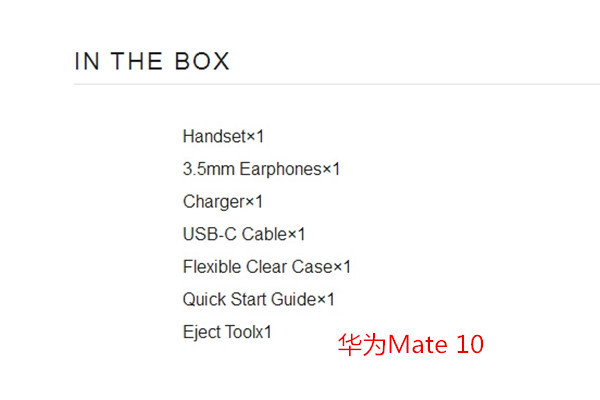[PConline News] Huawei recently unveiled the Mate 10 and Mate 10 Pro. The standard Mate 10 features a 16:9 screen ratio and front-mounted fingerprint sensor, while the Mate 10 Pro comes with an 18:9 full-screen display and a rear-mounted fingerprint scanner. Beyond these differences, foreign media has now revealed another design distinction between the two models: the Mate 10 Pro has done away with the 3.5mm headphone jack, whereas the Mate 10 still retains it.


According to reports from Phonearena, the official Huawei terminal page confirmed that the Mate 10 Pro no longer includes a 3.5mm audio jack. Instead, audio output is now handled via the USB Type-C port. This means the Mate 10 Pro supports advanced audio codecs like aptX, aptX HD, and LDAC, as well as DP1.2 video output. While this decision may seem confusing at first, Huawei has provided users with a USB-C to 3.5mm adapter and a USB-C headset to ease the transition.

In Europe, the Mate 10 is priced at 699 euros (approximately 5,437 yuan), while the Mate 10 Pro costs 799 euros (around 6,213 yuan). The BNM version of the Mate 10 will be released on October 20th. If all goes smoothly, it will be available through all channels on the launch day, and its pricing is expected to be significantly higher than the European release price.
Overall, the Mate 10 series continues to showcase Huawei's commitment to innovation, with the Pro model pushing the boundaries in terms of design and connectivity options. Whether this shift to USB-C for audio is a step forward or a potential inconvenience for users remains to be seen, but it's clear that Huawei is making bold moves in the smartphone space.
Large span cable trays are a type of cable management system used to support and protect electrical cables in industrial and commercial settings. These trays are designed to span long distances without the need for additional support, making them ideal for use in large facilities with expansive cable networks.
The primary function of large span cable trays is to provide a secure and organized pathway for electrical cables. They are typically made from metal or fiberglass and are available in a variety of sizes and configurations to accommodate different cable types and installation requirements.
One of the key advantages of large span cable trays is their ability to support heavy loads over long distances. This is achieved through the use of sturdy construction materials and specialized design features such as reinforced side rails and cross members.
In addition to their load-bearing capabilities, large span cable trays also offer excellent ventilation and heat dissipation properties. This is important for electrical cables, which generate heat during operation and must be kept within a safe temperature range to prevent damage or failure.
Another benefit of large span cable trays is their flexibility and adaptability. They can be easily customized to fit specific installation requirements and can be configured to accommodate changes in cable routing or network expansion.
Large span cable trays are commonly used in a wide range of industrial and commercial applications, including power generation and distribution, oil and gas processing, chemical manufacturing, and transportation infrastructure. They are also used in data centers and other high-tech facilities to support complex networks of electrical and data cables.
Overall, large span cable trays are an essential component of modern electrical infrastructure. Their ability to provide secure and organized cable management over long distances makes them an ideal choice for a wide range of applications, from small-scale installations to large, complex facilities.
Large Span Cable Tray,Durable Large Span Cable Tray,Flammable Large Span Cable Tray,Resistant Large Span Cable Tray
Rayhot Technology Group Co.,Ltd , https://www.cnrayhot.com
